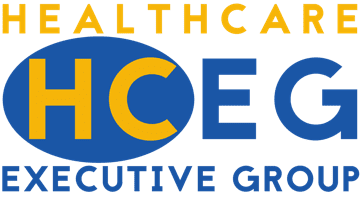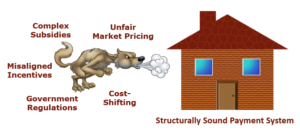
Each year over the last decade, ‘Healthcare Payment’ and ‘Data & Analytics’ have been on the HCEG Top 10 list of challenges, issues, and opportunities facing healthcare leaders; whether payment reform, big data and advanced analytics, payment integrity, or as in the case of the most current 2021 HCEG Top 10+ list: ‘Data & Analytics with respect to Costs.’ And now, the pandemic’s impact on healthcare provider revenue, the increasing financial responsibility of individuals for high and widely priced healthcare services, and multiple price transparency regulations such as the No Surprises Act and Transparency in Coverage are forcing stakeholders across the industry to address fundamental structural issues surrounding healthcare payments and provider reimbursement.
On Thursday, September 9th, the first in a series of Focus Area Roundtables on Payment Integrity and ‘Data & Analytics with respect to Costs’ took place with HCEG’s executive director Ferris Taylor joined by Kurt Fullmer and Andrew Cone, two healthcare industry leaders with MultiPlan – HCEG’s Focus Area Partner for ‘Data & Analytics with respect to Costs’. Seventeen other leaders from health plans, health systems, provider organizations including IPA’s, and industry consultants joined the roundtable discussion focused on the following topics:
1-How providers and payors – and plan members and patients – can find common ground in terms of payment and reimbursement
2-The ways the No Surprises Act may change the future of provider networks and reimbursement
3-How payment integrity must evolve to be considered by providers as fair and equitable
RELATED: Trends that are re-shaping payment integrity strategies
Finding Common Ground Among Payers, Providers, Plan Members, & Patients
Ferris kicked off the roundtable by asking how healthcare stakeholders could find common ground in terms of reimbursement. MultiPlan’s Andrew Cone noted the importance of keeping in mind the wide degree of variance that exists in the healthcare market across product types such as Medicare, Medicaid, Commercial, Group, Individual, etc. There’s a clear benefit to payers and providers to adopt consistent patient attribution approaches, quality measurement, and risk adjustment practices across all product types.
He also called out the way in which healthcare services are priced relative to other major products like buying an automobile and acknowledged that some controversial issues, gamesmanship, and outright bad behavior by some stakeholders have driven regulations like the No Surprises Act and that the next few years will be “very interesting” in terms of establishing common ground between healthcare’s stakeholders.
Listen here to Andrew Cone share context for establishing common ground among stakeholders. [11:32 – 13:31]
Value-based Care Programs Support Common Ground
One participant, a leader of a physician organization, shared her perspective that reducing or eliminating ongoing and often arbitrary changes to provider payments by payers and moving to more fixed, regular payments found in value-based payment programs would go a long way toward establishing common ground among healthcare stakeholders and reduce or eliminate the gamesmanship sometimes played.
It was noted the larger impact and ongoing challenge related to regional differences in care patterns and related reimbursement rates. And the challenges associated with defining levels of care at expected levels and consistently delivering those care at agreed-upon levels.
Listen here for additional impacts on establishing common ground. [19:25- 20:11]
New and Increasing Administrative Burdens Impact Costs and Payment Integrity
One participant shared their experience with increased costs associated with providing preventative care to patient populations vs. reactive care to a subset of a patient population. Others in the roundtable noted increased – and new costs – associated with identifying individuals in need of preventative services, capturing and reporting value-based measures, and identifying and accessing correct plan and community-based resources on behalf of their patients.
RELATED: Surprise Billing and the Impact for Payors
The Right Information at the Right Time
Increased levels of provider interaction with plans on behalf of their patient population were identified as a recurring cost driver. One health system leader both praised and bemoaned the challenge of identifying and complying with different clinical care guidelines in markets served by multiple plans. She shared how each plan dictated different clinical guidelines and procedures and the fact that coverage for many services – particularly those associated with certain specialties like cardiology – was hard to ascertain, often not a covered benefit, and ended up being a patient responsibility frequently borne by the provider.
The ability to accurately identify benefits and reimbursement amounts on a timely basis – combined with clear clinical guidelines – was identified as a key means to control overall costs while at the same time doing the best for the health and well-being of the patient/member.
Length of Time a Person Remains with a Single Payer/Plan
One individual associated with a health plan noted the hesitance of funding preventative care for plan members who may not remain with the plan for more than a short period of time. For payers and care providers in risk-sharing arrangements, the cost of preventative care interventions is not typically recouped in a plan year. They noted the likelihood of benefits associated with proactive care accruing to subsequent plans and the need to compensate clinicians and payers for delivering preventive care whose benefits are derived over multi-year periods. A topic for future discussion would be to explore the policy levers that could help to address this issue.
Impact of No Surprises Act on Provider Networks and Payment Integrity
The roundtable transitioned the discussion to the No Surprises Act where participants discussed what impact the No Surprises Act might have on the future of provider networks and reimbursement. MultiPlan’s Kurt Fullmer shared a quick overview of the Qualified Payment Amount component of the No Surprises Act and participants continued discussing the following related considerations:
Qualifying Payment Amounts as Regional Values Subject to Negotiation
QPA’s are regional values set by both providers and payers in a particular area that will be subject to a ‘baseball-style arbitration process if not mutually accepted by providers and payers.
RELATED: What is a Qualifying Payment Amount?
Compliance with State vs. Federal Regulations & Policy
The need to understand and reconcile the federal No Surprises Act with state-level regulations was also discussed. One participant, a finance leader for a health system in southern California where out-of-network billing and payment law AB 72 has been in effect since 2017, noted ‘little to no non-compliance’ and expected the same with the No Surprises Act. Another participant, a leader at a PPO & IPA in the state of Washington, noted a similar experience with that state’s Balance Billing Protection Act that went into effect in January of 2020.
Removing the Patient from the Middle of Payer-Provider Payment Disputes
Kurt offered that in the interest of goodwill and patient experience, payers and providers may want to remove the patient from any payment dispute process as soon as possible.
Will Administrative Cost of Independent Dispute Resolution Force Providers to Join Networks?
While two participants noted that disputes are rare in their states which have already implemented surprise billing regulations, they and other participants agreed that direct costs associated with the dispute resolution process – and indirect costs associated with patient experience – are not insignificant and would be a consideration by any stakeholder entering dispute resolution.
One participant proposed that costs associated with dispute resolution – both direct and possibly more so with indirect patient experience costs and pressure from health systems – may force many currently non-contracted providers to join plan networks. Another participant disagreed and noted the ongoing physician shortage exacerbated by the pandemic supports non-contracted providers’ reluctance to join networks.
What Enablers Must Be Achieved to Realize Fair & Equitable Payment
The final topic Ferris presented to the roundtable was to solicit perspectives and feedback on what enablers need to be in place to achieve the overall goal of a fair price for a fair service in the most frictionless way possible. Participants agreed that while regulations cannot be ignored, that establishing common definitions, increasing meaningful collaboration and understanding between payers and providers, and working together to build transparent provider networks are primary enablers to achieve fair and equitable payments that address patient needs.
Listen here to Andrew Cone on the need for standard definitions as enablers of fair and equitable payment. [40:40 – 42:28]
Building a Fair and Equitable, Structurally Sound Payment System
If nothing else, this first roundtable on payment integrity and provider reimbursement clarified that the healthcare payment system remains broken with several long-standing structural issues that must be addressed. HCEG’s Ferris Taylor proposed that healthcare needs a solid, ‘concrete’ payment system foundation capable of withstanding the ongoing ‘huffs and puffs’ of various Big Bad Wolves involved with the current payment system: cost-shifting between stakeholders, misaligned incentives, unfair market pricing leverage, complex subsidies, and an increasing number of often ill-defined and conflicting government regulations and mandates – among other things.
More on Payment Integrity & Provider Reimbursement

Learn more about other Focus Area Roundtables here and consider joining our upcoming webinar series where information and thought leader insight and opinion of healthcare executive priorities will be presented.
If you’re not already a subscriber, join our newsletter of 5000+ other healthcare leaders and changemakers.









